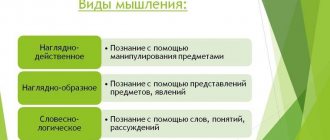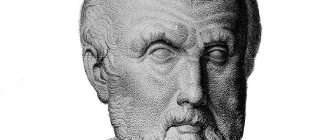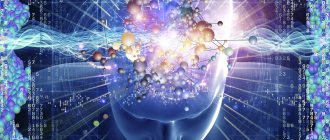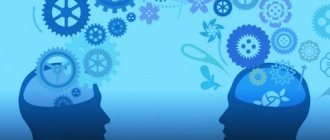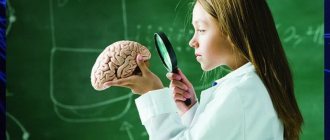Exploring this world, and then engaging in its transformation, a person constantly reveals the natural and stable connections that exist between phenomena. All this is indirectly reflected in his consciousness. This happens both when, looking at the wet asphalt, we understand that it has recently rained, and when a person establishes the laws of motion of celestial bodies.
In all cases, he reflects the world indirectly and generally, making certain conclusions, comparing facts, and also identifying patterns that take place in a wide variety of groups of phenomena. For example, without seeing elementary particles, man managed to understand their properties. And even without visiting Mars, I learned a lot about it.
Concept of thinking
Every day and constantly a person receives a wide variety of information from the outside world. As a result of the work of our senses and organs, smells and sounds, visual images, tactile and taste sensations become available to us. A person also receives certain data about the state of his body. This process occurs due to direct sensory perception. This is the primary building material with which thinking will have to work in the future. What is it? Thinking is the process of processing received sensory data, their analysis, comparison, generalization and inference. It represents the highest activity of the brain, as a result of which unique, new knowledge is created. That is, information that until this moment was not yet in the sensory experience of the individual.
What do we mean by thinking?
Thinking should be understood as the process of cognition and modeling of reality using generalized and indirect conclusions obtained on the basis of human activity. Philosophers of all times have emphasized the process of thinking as a distinctive feature of human nature. According to Descartes, thinking confirms the existence of life within the individual.
In the course of thinking, a thought becomes “tangible”, a concept is born, an idea comes to life. The process of thinking is contrasted with sensation and perception, as lower forms of consciousness, characteristic of the animal world.
Thinking fills human activity with meaning and acts as a support for the development of science and art. Based on this, many results of labor have, in addition to pragmatic, symbolic meaning: for example, the appearance and location of architecture, the material of construction of a building have no less meaning than its direct purpose.
Mental operations, first of all, appeared as practical, and then they were transformed into theoretical ones. Therefore, action is essentially the primary form of thinking. Experience confirms the dependence of the quality of completing a task on the articulation of its formulation.
A distinctive feature of thinking in comparison with other forms of consciousness is the ability to receive information indirectly. The process is carried out using brain functions - deduction and analogy.
Birth of a thought
Everyone knows that this process occurs in the brain. However, few people know exactly how a thought is born. And this is far from simple.
The leading role in thinking, as well as in all mental activity, is assigned to nerve cells - neurons. And a person has more than a trillion of them. Moreover, each of the neurons is a kind of factory that processes incoming data. Numerous connections extend from each nerve cell. They are connected to other neurons. It is thanks to this that nerve cells exchange electrochemical impulses with each other, which carry certain information. The data transfer speed is 100 meters per second. This is where the specific operations of thinking lie.
You can imagine a similar process in the form of bright fireworks. First, one bright star appears. This is a signal received from an external stimulus. Further, such an impulse seems to scatter along the chain of nerve cells in depth and breadth. All this is accompanied by new outbreaks that cover increasingly large areas of the brain.
The most interesting thing is that the impulse, when passing through the neural chains of the brain, overcomes certain obstacles that are located in the places where the nerve fibers connect. And this, of course, somewhat reduces their speed. However, each subsequent impulse moves along this path much easier. In other words, a person who forces his brain to work finds it much easier to think.
Of course, knowledge has high value for people. However, we need them primarily as material for thinking. That is why a person does not become smarter when he gains new knowledge. This happens as a result of their comprehension and inclusion in activities.
Types of thinking
In the brain, information processing occurs in different directions. This is created by different types of thinking that help us solve hundreds of daily problems.
The various tools that are in the arsenal of our brain, namely generalization and systematization, synthesis, analysis and much more, allow us to most fully perceive the world around us and develop. However, they are only individual elements of large-scale processes occurring in consciousness. The main types of thinking that serve as basic constructs in a person’s perception of the world around them include:
- practical or concretely effective;
- concrete-figurative;
- abstract.
The listed types of thinking differ from each other in the characteristics of the tasks they perform. The latter can be practical or theoretical.
The role of images in mental activity
Divergent thinking - what is it?
The development of thinking begins in early preschool age. The child needs it to form vivid ideas about the world around him. However, this does not mean that adults do not need figurative memory. This skill is needed for:
- Storing in memory memories of bright events in life;
- Opportunities to enjoy music;
- Engage in dancing and other types of amateur performances;
- Creation of new works of art, literature, painting;
- Form a visual result of the activity in the mind, which allows you to speed up the process of achieving it;
- Creative approach to solving assigned problems.
Additional Information. Imaginative thinking does not guarantee absolute correspondence to the reality of the image that is stored in a person’s memory. The key points of what is seen or heard are recorded in the mind, the rest is thought out by the human brain on its own in a rational way. Therefore, the products of imaginative thinking are somewhat idealized.
Abstract thinking
How is it preferable for a person to think - concretely or abstractly? There is no clear answer to this question. Of course, in the real world there are no abstractions. What we see around us contains only concrete phenomena and objects. Abstractions take place only in the sphere of human thinking. For example, a specific birch tree grows under the window. It exists in reality. However, it is quite possible to abstract this birch with all the trees, calling it the abstract word “tree”. After this, the chain is not difficult to continue. Birch can well be called a plant, a living being, a material object, and simply an object. Each of the subsequent concepts is an even greater abstraction, that is, a generalization of a specific phenomenon.
There is nothing wrong with this type of thinking. Without it, it is impossible for a person to solve complex problems. It is in such cases that both abstract and concrete thinking are used.
However, sometimes certain problems may arise. If the volume of abstract and concrete thinking outweighs in favor of the first, it is considered that the person has mentally left the real world, moving into the imaginary one. And the latter, strictly speaking, exists only in his fantasies.
Concrete thinking is activated by people when they have clear information, knowledge and understanding of what is happening. What if all this is missing? Then abstract thinking turns on. At the same time, a person guesses, assumes and draws accurate conclusions.
Using abstract thinking, we do not take into account concrete details. Our discussions concern general concepts. In this case, a person considers the picture as a whole, without affecting the accuracy and specifics. Thanks to this, he manages to move away from dogmas and rules, considering the situation from different angles.
Abstract thinking is very useful when a person is at an intellectual impasse. In the absence of knowledge or information, he has to guess and reason. And if we abstract from specific details, then we can consider in the current situation something that was not visible before.
Abstract logical thinking
With this direction of the mental process, a person operates with those phenomena that he is not able to smell, see with his eyes or touch with his hands. Abstract-logical thinking uses only a few of certain patterns, isolated from the imaginary, abstract qualities of the subject of research.
Abstract-logical and concrete thinking are closely intertwined with each other. An example of this is the explanation using mathematics of those phenomena that do not exist in nature. So, when we talk about the number “2”, we understand that we are talking about two units. But at the same time, people also use this concept to simplify certain phenomena.
Another clear example is language. In nature there are no letters, no words, no sentences. Man himself invented the alphabet and composed phrases to express those thoughts that he wants to convey to others. This allowed people to find a common language with each other.
The need for abstract logical thinking arises in situations where there is some uncertainty that leads to an intellectual dead end.
Functions and processes
This or that type of thinking activates a list of processes that ensure knowledge of the picture of the world:
- Comparison.
Identification of similar and distinctive properties and qualities; - Analysis.
Consideration of a phenomenon in the light of its details and components; - Synthesis.
The opposite of analysis; with its help the whole can be restored by identifying connections; - Abstraction.
Presentation of a certain quality of an object against a background of less significant ones; - Generalization.
Ignoring individual features in order to comprehend common ones and identify significant connections between objects.
For a child’s level of thinking, all of the listed processes must be reflected in practice: disassembling and folding parts, classifying them according to certain characteristics.
Depending on the functional characteristics, thinking in psychology is divided into reproductive, productive and creative:
1. Reproductive.
It has the form of repeating the studied information according to an established algorithm. In practice, this looks like the ability to solve problems according to the principle of previous ones. The thinking process is concentrated not on mastering new things, but on fixing one or another pattern.
2. Productive.
Thinking in which a person goes beyond existing concepts and supplements his level of understanding with new knowledge. Their novelty is such only for the individual, not counting the “universal” objectivity. If the information received by an individual represents an innovation for all humanity, then we are talking about creative thinking.
3. Creative.
A process characterized by complexity and structure. The individual strives to acquire new knowledge and independently apply it in practice. Characteristic features: uniqueness, creation of something new, not repetition; applying a different point of view to a phenomenon for the purpose of broader consideration; the spontaneity of an idea that was not preceded by anything from the current situation; transformation of the familiar.
Specification
When abstracting, a person is mentally distracted from certain aspects and features of the object. This allows him to gain a deeper understanding of the essence of phenomena and things. Concrete thinking is the exact opposite of abstract thinking. It returns thought from the general to reveal its content.
It is worth noting that any human reasoning always has the goal of obtaining some result. A person compares and analyzes objects using concrete thinking. He also abstracts some of their properties, with the help of which he reveals in them those patterns that govern the object of study.
Visual-effective thinking
Thanks to the work of the brain, a person is able to understand the world around him and act in it. One of the types of concrete thinking is visual-effective. It has been the basis of such human activities since primitive society. Visual-effective, or concrete-effective thinking has always been responsible for solving practical problems facing a person. An example of this is the problem of cultivating land or building a home.
An effective, concrete style of thinking manifests itself in a person from the first months of his life. In addition, up to 3 years it is his main one. And only by the age of three is concrete imaginative thinking activated, allowing one to solve emerging problems in the imagination.
Starting from an early age, the baby is able to analyze objects in close proximity to him due to direct contact with them. He touches them with his hands, connects and separates them. Many children often break their toys. However, parents should not scold them for this, because for a child such an act is not at all pampering or hooliganism. When breaking a toy, the baby tries to see what is inside it. And this can be called an early research step.
In the process of solving various practical problems, the child develops the ability to think. At the same time, he uses specific situational thinking. The kid acts like a great Roman operator: “I came, I saw, I conquered.” A small child’s thinking is based on the current situation in which a certain object is involved. Specific situational thinking is implemented immediately in actions. An example of this is a situation when a two-year-old child tries to take a toy that is too high for him. Without reaching it with his hands, he will definitely climb onto the chair next to him.
Examples of concrete thinking of the visual-action type in older children are the same actions. However, the child’s behavior in this case will be more skillful. This suggests that with age, concrete thinking of an effective type does not go anywhere. It just takes slightly different forms. And already older schoolchildren rely in their thinking process on their existing experience in solving problems, imagining the potential consequences of their own actions. All this allows the child to smoothly move to the next, more complex stages of development of the thinking process.
Nevertheless, a visually effective concrete type of thinking cannot be considered inferior or primitive. It is also present in adults in their objective activities. Examples of this include cooking soup, knitting socks, or repairing a bathroom faucet. For some adults, concrete logical thinking prevails over figurative and abstract logical thinking. Such people are spoken of as masters from God, having golden hands (by the way, it’s their hands, not their heads). These specialists are capable of repairing the most complex mechanism without completely understanding the principle of its operation. While disassembling the unit, they realize the reasons for its breakdown. Having assembled the mechanism, they will not only restore its functionality, but also improve it.
Modern types of thinking: general characteristics of thinking and methods of development
However, these are not all the types of thinking that modern psychologists and cognitive specialists identify. In our life we cannot do without the ability to think strategically, critically and imaginatively. But these are also types of thinking. They are the ones who help a person to be successful, set ambitious goals and achieve them.
So, let's look at what popular types of thinking exist, what they are, and what methods and exercises can be used to develop them.
Necessary types of thinking for a modern person:
- Critical thinking.
- Strategic thinking.
- Logical thinking.
- Analytical thinking.
- Thinking outside the box.
- Creative or creative thinking.
- Systems thinking.
- Creative thinking.
- Spatial thinking.
- Abstract thinking.
- Algorithmic thinking.
- Deductive thinking.
- Associative thinking.
- Mathematical thinking.
By the way! Our readers now have a 10% discount on any type of work.
Critical thinking
What is critical thinking and how to develop it? The ability to think critically means the ability to doubt, ask questions, analyze, form judgments based on received arguments and defend one’s point of view.
Critical thinking is an essential skill for a student. It is he who helps to choose the right literature and competently work with sources during the preparation of coursework, dissertations and other works.
How to develop critical thinking in an adult? There are several proven methods:
- constantly improve knowledge, learn new things and expand your horizons;
- communicate with smart people;
- learn to ask questions and look for answers;
- read a lot and analyze what you read;
- explore different points of view;
- come up with different options for how situations might develop;
- analyze mistakes and failures, draw conclusions;
- play chess, board games;
- solve puzzles and rebuses.
Solving puzzles helps develop thinking
Strategic Thinking
Strategic thinking is the ability to assess the risks of your actions and anticipate the consequences. Any thinking person must develop the art of seeing and creating strategies to achieve success in different areas of life.
What examples of strategic thinking can you give? The most relevant is the attitude towards learning. If a student makes a study and preparation plan at the beginning of the school year, this strategy will allow him to prepare for tests and exams with ease and confidence. But the “at random” attitude is more likely to lead to a retake.
How to develop strategic thinking? Focus on the following skills:
- observe events and look for general trends;
- ask difficult questions and try to find answers to them;
- always evaluate actions in terms of possible consequences;
- learn to think logically and clearly;
- make decisions and take responsibility;
- take time to take stock and evaluate the situation;
- constantly learn something new to expand your knowledge;
- learn to be open-minded;
- put yourself in another person's place.
Logical thinking
Logical thinking is the ability to think logically, reasoning consistently and consistently.
How to develop logical thinking as an adult? This is a very important question. After all, logic helps not only in study and work. She is an excellent travel companion in any life situation. So take note of the following exercises and ways to develop logical thinking:
- solve logical problems;
- read and analyze the texts you read;
- solve scanwords, crosswords and puzzles;
- look for logical patterns;
- study foreign languages;
- learn to write with your left hand if you are right-handed, and vice versa.
Writing with your left hand if you're right-handed is a great way to practice thinking.
Analytical thinking
Analytical thinking is the ability to work with large data of information, dividing them into logical parts and examining each according to a certain scheme.
It is impossible to think analytically without well-developed logic. Therefore, in searching for an answer to the question: how to develop analytical thinking, do not forget about the advice from the previous paragraph and supplement them with the following:
- solve math problems;
- analyze situations and information;
- look for alternative solutions;
- participate in discussions;
- learn to create smart and clear notes;
- simulate different situations.
Thinking outside the box
Non-standard, or lateral thinking is the ability to think outside the box in ordinary situations and look for unexpected solutions.
British psychologist Edward de Bono studied issues of lateral and creative thinking, and shared his findings in books. For example, in his work “Six Thinking Hats” you can find simple and effective exercises that help develop non-standard thought processes.
British psychologist Edward de Bono
How to develop unconventional thinking? Use proven exercises:
- go beyond: always look for additional solutions and properties, not limited to standard conditions;
- look for ways to use it: take any item and come up with at least 100 options for how it can be used;
- connect random words: find relationships between different objects and phenomena.
Creative or creative thinking
Creative or creative thinking is very similar to lateral thinking. It also characterizes a person’s ability to create something new and non-standard, bypassing the usual rules and patterns. The ability to think creatively helps you come up with ideas and change this world for the better.
Creativity is the most important soft skill of our time. HR managers of large companies want to see this skill not only in specialists in creative professions, but also in managers and technical workers.
How to develop creative or creative thinking? Use the following proven techniques:
- change the situation, go beyond;
- switch between tasks rather than sit on one thing;
- come up with ideas on your own and discuss them in a general brainstorming session;
- listen to happy music - studies say it improves creative thinking;
- develop a sense of humor and a positive attitude towards life;
- reproduce other people's ideas and create your own based on them.
Systems thinking
The ability to think systematically is an important skill for managers. But it will also be useful in any professional field. After all, systems thinking is a holistic perception of phenomena and objects, the ability to find and create a system by working with information, people and companies.
Systematic thinking is important not only for professional development. This ability helps to organize life, set goals and see ways to achieve them.
How to develop systems thinking? Perform simple steps every day:
- look for a system in all situations and processes;
- find the main elements that make up the system;
- develop the ability to analyze and synthesize;
- approach every situation critically;
- try to predict the development of the system;
- develop the ability to reflect, that is, conduct introspection and evaluate oneself from the outside;
- Read books to develop systems thinking, such as Ian McDermott and Jane O'Connor's The Art of Systems Thinking.
Seeing a system in everything is an invaluable skill that will definitely come in handy in life.
Creative thinking
Imaginative thinking is the ability to “draw” mental images of phenomena and objects that are not in the immediate environment.
Figurative thinking, as a rule, relies on a person’s visual memory. But this does not mean that we cannot imagine abstract phenomena or animals that we have never seen. In this case, everyone will have their own images.
How to develop imaginative thinking? For this, psychologists recommend different exercises. For example:
- study objects, people, natural phenomena, and then describe them with your eyes closed;
- choose abstract phenomena and try to mentally draw their images;
- develop photographic memory;
- observe clouds or other abstract phenomena and find images.
Spatial thinking
Spatial thinking is a type of figurative thinking, which is characterized by the ability to navigate well in space, as well as mentally create three-dimensional images and forms.
How to develop spatial thinking? Even if you skipped geometry classes as a child at school and always suffered from topographic cretinism, there are methods that will help improve this ability:
- solve geometry problems;
- try to draw mental maps of the area;
- start designing airplanes, castles, etc.;
- collect puzzles;
- draw mirror reflections of paintings;
- play board games.
Abstract thinking
Abstract thinking is one of the types of thinking that allows you to create abstract concepts and operate with them.
It is the ability to think abstractly that helps a person communicate, learn different languages, count and read, and write.
How to develop abstract thinking? To do this, you can use the following methods:
- imagine different emotions;
- read the book in reverse order;
- come up with contradictory phrases;
- make up abbreviations;
- choose an item and write down all its functions and properties;
- write down all the words starting with a certain letter within a limited time;
- give names to life events.
Brainstorm with friends to develop your thinking
Algorithmic thinking
The algorithmic type of thinking includes the ability to direct the thought process to solve certain problems, see other people’s algorithms and create your own.
Algorithmization of processes is their description with mathematical symbols, in which it is necessary to reflect the basic acts of the processes, their sequence and interconnection.
If you want to go into IT, you just need to know how to develop algorithmic thinking. Here are some ways:
- study computer science;
- play strategy games;
- get involved in programming;
- break down different processes into steps.
Deductive Reasoning
Deductive thinking is the ability to draw specific conclusions from general phenomena. That is, it is a skill that allows you to notice small details and come to accurate conclusions.
Deduction is also an important research method that students use in the practical part of coursework and dissertations. So a well-developed skill will help you not only guess moves in the Sherlock series, but also be a great student.
How to develop deductive thinking? There are several important and useful ways:
- pay attention to little things;
- develop memory;
- learn to formulate thoughts clearly and logically;
- deeply study the chosen field of knowledge;
- train concentration;
- study other people's body language;
- keep a diary and record all the events of the day;
- develop intuition;
- solve puzzles and logic problems;
- learn to listen and hear others;
- read a lot.
Becoming a real Sherlock is a very real task
Associative thinking
Associative thinking is a person’s ability to see and create relationships between different images.
The ability to associatively helps a person better remember information, imagine different ideas, create stories and find relationships between phenomena. How to develop associative thinking in adulthood? There are several ways:
- build associative chains between different words;
- remember a number of words through associations;
- look for associative definitions for different phenomena;
- come up with unusual associations for familiar objects.
Visual-figurative thinking
The main means of mental activity of this type are images. They, in turn, are the result of understanding reality and its sensory perception. In other words, the image is not represented as a photographic imprint of the object. It is the result of the work of the human brain. That is why the object mentally created by an individual has some differences from the original.
People's thinking is capable of operating with three types of images. Among them:
- Images of perception. They have a direct connection with the human senses and represent smells, sounds, pictures, etc. Such images also cannot be compared with a photographic copy of reality. After all, a person may always fail to see certain details or not hear something. The brain will complement and conjecture everything that is missing to create a complete picture.
- Images-representations. This is information that continues to be stored in human memory for a long time. Over time, such images become less and less accurate. Not very important and significant details are forgotten or lost.
- Images of the imagination. These elements represent the result of one of the most unknown cognitive processes. Using imagination, a person is able to recreate the desired image from a description or come up with an object that he has never seen in his life. Nevertheless, all this has direct connections with reality, since it is the result of combining and processing the information that is stored in human memory.
Each of the listed types of images takes an active part in the cognitive activity of the individual. They are also used when a person performs abstract logical thinking. Without creating images, it becomes impossible to solve various problems, as well as creative activity.
Types of thinking
Psychologists also distinguish different types of thinking. Usually each type divides people into two categories
:
- Logical - ethical
. Representatives of the first type reason in terms of patterns, rules, and logical connections. People from the second type think based on feelings, experiences, and mood. For the former, communication is an exchange of information, and for the latter, it is an exchange of energy and emotions. - Sensory – intuitive
. The first type involves concrete and practical thinking, its representatives are good at noticing details; they reason from the point of view of current events, understand the current situation. The second type is global, philosophical thinking, while it is theoretical and divorced from the current situation. - Decisive - judicious
. People of the first type make decisions quickly and can act in a tense environment; They often make mistakes, but quickly correct the situation and learn from their mistakes. People of the second type take a long time to make decisions, they are used to acting in a calm and comfortable environment, and avoid unnecessary actions. - Schizothymic - cyclothymic
. Schizothymic people are characterized by subtlety of feelings, selfishness, power, and the desire to be better than others. In ordinary life they show some signs of schizophrenia. Cyclothymics are prone to manic-depressive syndrome; they are irresponsible, carefree, cheerful and sociable. - "Changer" - "runner"
. People of the first type are oriented towards various actions, each time they do something new. But “runners” prefer to do one thing until they complete the task; they are conservative in everyday life, carefully choosing friends, communication, hobbies, and purchases. Such people do not adapt well to sudden changes. - Introverts - extroverts
. This division is well known: the thoughts of the former are directed primarily at their inner world, and the thoughts of the latter are directed primarily at the external world. The former are sensitive, reserved and reasonable, while the latter are active, sociable and open. - Internals - externals
. People of the first type believe that everything that happens to them depends only on their personal qualities. They blame only themselves for all adversity, and rejoice in success as their achievements. People of the second type are sure that everything around them happens due to external circumstances: the actions of other people, chance, “fate,” etc. - Positivism - negativism
. People of the first type see in a situation primarily the qualities that it contains. They reason in affirmative constructions: “What is the weather now? “It’s good, it’s warm outside.” Negativists first notice in the same situations qualities that are absent in them, and reason with negative constructions: “What is the weather now? “Not bad, it’s not cold outside.”
In each of these types, mental activity has its own specifics. In particular, the ability to make true and false conclusions depends on this. However, overly pronounced representatives of either side tend to constantly make logical errors. These are, say, externals and internals. They often cannot objectively assess the situation and are guided by the simplest initial attitudes: “This happened because of me” or “This happened because of others,” when in fact the situation occurred due to a confluence of many circumstances. And it contains both part of the fault of the person himself and part of the fault of the environment.
Since we are talking about logical errors, it is worth considering a type of thinking that is initially erroneous. This is the so-called predicative thinking, which psychologists contrast with logical thinking. A predicate, or predicate, is what is said about an object, its quality or action that is relevant at the time of utterance. “Predicativism” is a type of reason when a person identifies dissimilar objects due to the same predicate.
Example: “Muslims do not eat pork. Vasya doesn't eat pork. Therefore, Vasya is a Muslim.” The error in reasoning is obvious. The correct reasoning in this case would be: “Muslims do not eat pork. Ahmet is a Muslim. Therefore, Akhmet does not eat pork.” The predicate is not an essential feature of the subject; it is relevant only at the time of utterance; therefore, the same predicative can be applied to many unrelated objects. Not only Muslims do not eat pork, but also vegetarians (they generally refuse meat), the poor (they simply do not have money for pork), glass bottles (these are inanimate objects, they cannot eat), etc.
Despite its initial fallibility, predicative thinking is common to many people. This is precisely the irrational type of reason on which political ideology and propaganda, religion, advertising and marketing are based. Examples of “predicativism” can easily be found in advertising slogans: “All successful people use this brand of shampoo!” — the consumer’s reaction is expected: “I use this brand of shampoo, therefore, I am a successful person.” Such a consumer will continue to use shampoo of this brand in order to maintain the status of a “successful person.” “Predictive people” are thus very easy to control, they are suggestible, and they can be easily deceived.
It was precisely this predicative type of reason that became the cause of the medieval “witch hunt,” when sorcerers and witches were found by external signs: red hair color, special clothing, voice, etc. (all these are signs that are insignificant for an object with the status of “witch.” "). It also gave rise to nationalist, racist theories, religious intolerance, and clashes between different youth subcultures. Nowadays, the predicative mind rules the so-called consumer society. Everyone wants to be like successful people, “cool”, rich and famous, while being similar purely in appearance. The “typical consumer” does not understand that Pavel Durov is successful not because he has a lot of money, but because he is a talented programmer, the developer of several large projects (and only because of this he has a lot of money). Predicative reason gives rise to such a phenomenon as envy, while the person himself does not understand what exactly he is envious of.
Formation of a visual perception of the world
Concrete-figurative thinking has its own specificity. Being a higher level of brain function, it does not particularly need words. Through feelings and images, you can even express some abstract concepts, such as, for example, resentment and love, hatred and loyalty.
As mentioned earlier, the formation of concrete visual thinking in a child begins at about three years of age. The peak of its development is considered to be the period from 5 to 7 years. It is no coincidence that children at this age are often called artists and dreamers. This is the time when they have already mastered speech well. However, children’s words do not at all interfere with the images they create. They only clarify and supplement them.
The language of images is considered more difficult than speech. Much more imaginary objects can be created. At the same time, they are, as a rule, very diverse and have a wide range of sensual shades. That is why it is hardly possible to select the words available in a person’s arsenal to designate images.
Concrete-imaginative thinking is the basis of creativity, which is considered the basis of the higher process of cognition. It is not only musicians, poets and artists who have it. Concrete-imaginative thinking is characteristic of those people who have a high level of creativity and constantly invent something new. But for most people it fades into the background. In this case, primacy shifts to an abstract-logical perception of the world.
Levels of Thinking
Human brain activity, aimed at solving problems and understanding the world around us, has its own indicators of development. This includes the specific level of thinking used by a person, namely:
- Reason. It is the initial level of thinking. In this case, the operation of abstractions is carried out within a given template, an unchanging scheme and a rigid standard. Reason is the ability to reason clearly and consistently, to carry out the correct construction of one’s thoughts, to strictly systematize and clearly classify facts. Its main functions are division and calculation. The logic of reason is formal. She studies the structure of evidence and statements, while paying attention to the form of already “ready-made” knowledge, and not at all to its development and content.
- Intelligence. It is also considered dialectical thinking. Reason represents the highest level of cognition of the rational type, the characteristic features of which are the creative operation of created abstractions and the study of their nature (self-reflection). The main task of this level of thinking is the unification of various components, including the synthesis of opposites, with the identification of the driving forces and root causes of the phenomena being studied. The logic of reason is a dialectic presented in the form of a doctrine of the development and formation of knowledge in the form of the unity of its form and content.
Types of use
Images arise from events, knowledge stored in memory, or are recreated by imagination. A person relies on them when planning his actions, perceiving reality, finding a way out of problematic situations, and solving problems.
In music
Musical-figurative contributes to the understanding of music at the level of feelings, its comparison with familiar objects, natural phenomena, and events.
In the profession
The following professions are suitable for people with a developed ability to think in images:
- designer;
- inventor;
- director;
- artist;
- architect;
- other professions related to creativity and powerful visualization.
They can imagine what they have planned at the idea stage.
In art
Works of art reflect the author's attitude towards something. This is a synthesis of feelings, sensations, thoughts of the creator.
The ability to convey one’s inner world through an artistic image is a property of different types of figurative thinking.
Learning
Creates chains of knowledge by connecting information obtained in different lessons. Helps to apply them in different situations.




